
Ryanair has the largest commercial fleet in Ireland and is also building up its in-house maintenance capabilities.
For a country of little more than 5 million people, the Irish economy has long punched above its weight. Once mostly an agriculture-driven economy, Ireland has transformed into one based on advanced technologies and global exports. The country’s government has actively targeted investment from multinational companies over the past decade, with incentives including a corporate tax rate of 12.5% and strong intellectual property protections.
Ireland’s aviation sector has contributed to this trajectory by further growing as a hub for aviation leasing and finance as well as aftermarket services.
IDA Ireland, a quasi-governmental agency encouraging foreign direct investment into the country, has proactively targeted the aviation segment, and specifically MRO, as drivers for economic growth. It typically does this by hosting customized visits to Ireland for prospective investors, along with offering practical support and financial incentives to further entice companies to establish operations in Ireland. Tony Hayes, vice president for engineering, industrial and clean technologies for the U.S. Midwest at IDA Ireland, says of Ireland’s status as an aviation hub: “The Irish aviation cluster spans the industry value chain, encompassing everything from aircraft leasing, maintenance and recycling to component manufacture, parts repair and business aviation, avionics, technology and aftermarket solutions and beyond.” Hayes says in recent years, technology and innovation have become more important, citing areas such as inflight data acquisition and monitoring instrumentation, flight-testing hardware and software, and cybersecurity and flight management systems.
MROs Adding Capacity
Much of Ireland’s MRO activity is based in a cluster at Shannon Airport on Ireland’s west coast. Shannon has been an aviation hub since the 1940s, being the destination of the first transatlantic scheduled landplane passenger flight in 1945, and has since served as a gateway between Europe and the U.S.
While strong domestic-based MROs such as the Atlantic Aviation Group have operated in the area for more than 60 years, many MROs at Shannon demonstrate Ireland’s drive to capture overseas investment. These include U.S.-based STS Aviation Group, which has run STS Aviation Services Ireland’s modifications and interiors business since acquiring UJet in 2018. This investment influx has continued over the past year, with Shannon-based Eirtech Aviation Services included in a deal for U.S. private equity firm Tiger Infrastructure Partners to acquire International Aerospace Coatings in December 2022.

Another example of overseas investment is Lufthansa Technik Turbine Shannon (LTTS), which the German MRO giant has operated since 1992. The company specializes in repairing components for high-and low-pressure turbines for CFM- and GE-manufactured engines, supporting Lufthansa Technik’s overhaul shop along with third-party customers.
Pat Foley, who recently became CEO of LTTS, says its revenues and headcount are above 2019 levels, but issues such as supply chain constraints and meeting market demand persist. Inflation in Ireland—running at around 6.3% in August—has affected operations in several areas. “We’re seeing pressure on materials, labor costs and areas such as energy costs at our facilities—so it’s across the board,” Foley says. This year, LTTS opened a new facility close to its existing Shannon site focusing on the repair of engine manifolds to add further capacity, taking its engine repair footprint in Shannon to 1.1 million ft.2
Despite the impact of geopolitical issues on the Irish MRO segment, investment has continued not just at Shannon but also elsewhere in Ireland. U.S.-headquartered Panasonic Avionics, which has operated its Panasonic Technical Services business in Ireland since 2019, recently expanded its MRO center in Dundalk—increasing to 23,000 ft.2 from 6,000 ft.2 while tripling its workforce at the site. Meanwhile, in Celbridge in County Kildare, located 13 mi. west of Dublin, Lufthansa Technik opened a new mobile engine repair shop, doubling capacity for CFM56-5B and -7B maintenance to 10 engine bays.
Domestic MRO providers are also expanding abroad. Dublin Aerospace, a provider of services for auxiliary power units, base maintenance, integrated drive generator repairs and landing gear maintenance, has been based in the Irish capital since 2009 and operates a four-bay hangar close to the city’s airport. The company expanded its footprint into the UK after acquiring the Exeter-based maintenance division of defunct airline Flybe three years ago. The business now operates as Exeter Aerospace and focuses on maintenance for Embraer 170/190 regional jets, Bombardier Dash 8/Q400 and ATR 72 turboprop aircraft.
William Flaherty, CEO of Dublin Aerospace, says it has run Exeter Aerospace specifically to foster organic growth. “We have followed a startup trajectory, aiming to run at its capacity within the first five years,” he says. “The strategic plan includes the establishment of five lines of maintenance, which enhances efficiency and enables Exeter to cater to more aircraft in a streamlined manner.”
Across its network, Dublin Aerospace is looking to grow capabilities in component repairs and line maintenance, having recently opened a station in Belfast. Flaherty says the need for skilled labor is a particular challenge despite Ireland’s relatively strong technical training schools.
“We need governments to recognize and promote the importance of technical training in order to address the skill gaps across a number of industries and foster economic growth and competitiveness,” Flaherty says, adding that Dublin Aerospace plans to hire up to 100 more people across the business over the next few years. Meanwhile, Foley says LTTS has increased its headcount by around 100 over the past 18 months, with a lot of that talent coming from Shannon and surrounding areas.
Airlines Build In-House Capability
Much of Ireland’s commercial fleet is operated by flag carrier Aer Lingus and low-cost carrier Ryanair. Aer Lingus, part of International Airlines Group, has a fleet of 54 aircraft including Airbus A320-family and A330 types.
Like many carriers, Ireland’s airlines are looking to bring some MRO capability in-house to hedge against supply chain challenges and extended lead times. Javier Jimenez, chief technical officer at Aer Lingus, told Inside MRO this year that it was exploring bringing some component repairs in-house rather than relying too much on new components from constrained OEMs. Jimenez also cited a competitive recruitment market—especially in skilled areas such as B1- and B2-certified engineers—as a challenge but plans to address this by drawing on talent from European Union member states and its apprenticeship scheme, which takes on around 15-20 trainees annually.
Ireland’s largest aircraft operator is Ryanair, with more than 500 aircraft in its fleet—a number that will surpass 600 by 2026. This is anticipated to grow with the arrivals of more Boeing 737 MAX aircraft. The airline has commitments for up to 150 of the Leap 1B powered type.
While not engaged in any third-party MRO, Ryanair has been boosting the in-house repair capability of its engineering division, including sites in Dublin and Shannon and across Europe in Kaunas, Lithuania; Wroclaw, Poland; Seville, Spain; and Glasgow, Scotland. This drive gained speed during the pandemic, when the airline sought to in-source more maintenance capability to drive cost efficiencies, particularly in base maintenance up to the C check level. It also uses external MRO providers such as Joramco in Jordan, where it recently increased its maintenance lines to six for the 2023-24 winter season.
Domestically, Ryanair opened a new hangar in Shannon in 2022, which focuses on base maintenance of its fleet. The airline also announced a new €40 million ($42.2 million) four-bay facility at its Dublin main base. The 120,000-ft.2 facility is expected to open in the second quarter of 2025, adding capacity and creating 200 new jobs.
Buoyant Lessors Foresee Spare Engine Demand Spike
Ireland has become a world center of aviation leasing and finance, owing to tax treaties with numerous countries and the maturity of a liberal aviation legal framework over a 50-year period. There are more than 50 aircraft leasing companies operating in Ireland, with more than 60% of all leased aircraft worldwide managed by Ireland-based lessors. The $30 billion mega-merger in 2021 between AerCap and GECAS further boosted the country’s leasing infrastructure. SMBC Capital and Avolon are also headquartered in Ireland. Reflecting its large MRO footprint, Shannon is home to several prominent aircraft and engine lessors. These include Shannon Engine Support (SES), a Safran-AerCap joint venture specialized in the leasing of CFM56 and Leap family engines with a 50-50 split.
Tadhg Dillon, chief commercial officer (CCO) at SES, expects high demand for Leap 1A spare engines next year. “Most of this demand is forecasted to be driven by environmental issues; however, the first batch schedule removals should also start next year, driven more by staggering programs versus engine condition,” he says. “MROs continue to struggle with supply chain issues, lack of resources and capacity, all of which directly impact on turnaround time, which increases the demand for spare engines.”
Another major Shannon-based lessor is Engine Lease Finance Corp., which owns and manages 360 engines, of which 90% are for narrowbodies. CCO Richard Hough identifies the latest-technology narrowbody engines—the Leap and GTF—as driving the narrowbody engine segment forward, despite well-documented technical issues.
“The unprecedented ramp-up in delivery rates from both Airbus and Boeing, combined with the well-publicized technical issues, has resulted in an unanticipated level of early demand for MRO support, with a knock-on effect of increased demand for spare engines,” he says. “This increased spare engine demand has accelerated growth of the independent leasing market . . . we expect the Leap and GTF markets will mature into bigger and even more independently supported MRO and leasing markets than any of the preceding technologies.”
Hough says the widebody segment has lagged behind narrowbodies in terms of post-pandemic recovery. “But while it is recovering more slowly, it is doing so at a steady rate,” he adds.
